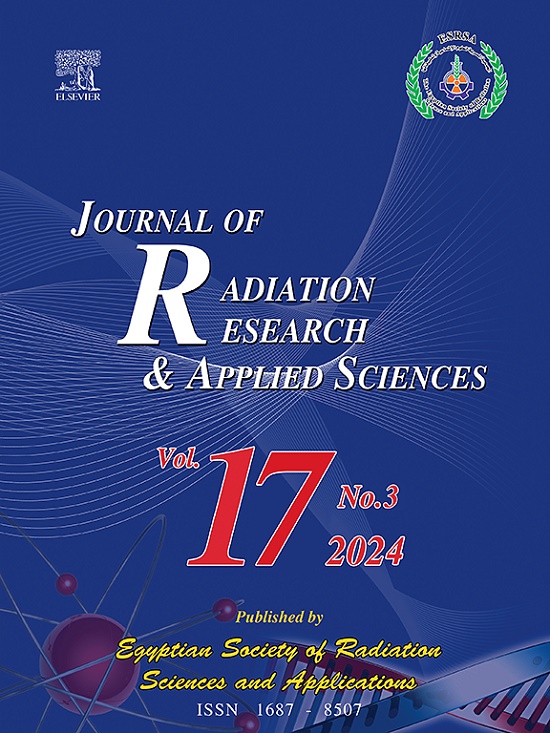Enhancing medical imaging with Ghost-ResNeXt and locust-inspired optimization: A case study on diabetic retinopathy
IF 1.7
4区 综合性期刊
Q2 MULTIDISCIPLINARY SCIENCES
Journal of Radiation Research and Applied Sciences
Pub Date : 2025-05-22
DOI:10.1016/j.jrras.2025.101622
引用次数: 0
Abstract
Diabetic Retinopathy (DR) is a global cause of vision impairment, necessitating early detection for effective treatment. Previous works on deep learning architectures like ResNet and DenseNet exhibit promising efficiency in DR detection. However, they're typically computationally expensive and sluggish, rendering them relatively unsuitable for real-time scientific purposes. Also, there are challenges associated with the existing models of displaying normality and the normal distributions to enhance hyperparameters, which often result in the models' generally poor performance. To lower the version complexity and maintain higher accuracy in low-light situations, this examines the cost of the significant GhostNet structure with the former high-throughput ResNeXt model to establish Ghost-ResNeXt. To improve the model performance even more, we propose a new algorithm called Locust-Inspired Optimization, which belongs to swarm intelligence inspired by biological processes. These rules pleasantly tune the model's hyperparameters by emulating the swarm behavior of locusts for the best feature selection and classification. The proposed method entailed training the Ghost-ResNeXt model on a large data set of retinal images. At the same time, the parameters were optimized with the aid of a locust-inspired optimization algorithm. The model design prevents intricate patterns of DR from overshadowing the computational burden while optimally retaining valuable diagnostic information. Experimental outcomes proved that the Ghost-ResNeXT is superior to the conventional architectures in terms of accuracy and pace, which resulted in a remarkable improvement in DR detection accuracy within a comparatively reduced range of parameters. The Locust-Inspired Optimization enhances model stability, achieving higher precision and recall than conventional optimization techniques. This paper provides a novel and useful resource-saving approach to DR identification, which can be applied in ‘live’ diagnostics and telemedicine.
利用Ghost-ResNeXt和蝗虫启发优化增强医学成像:糖尿病视网膜病变的案例研究
糖尿病视网膜病变(DR)是一种全球性的视力损害原因,需要早期发现以有效治疗。以前在深度学习架构(如ResNet和DenseNet)上的工作在DR检测方面表现出了很好的效率。然而,它们通常在计算上昂贵且缓慢,使得它们相对不适合用于实时科学目的。此外,现有模型在显示正态性和正态分布以增强超参数方面存在挑战,这往往导致模型的性能普遍较差。为了降低版本复杂性并在低光照情况下保持更高的精度,本文将前高通量ResNeXt模型与显著GhostNet结构的成本进行比较,以建立Ghost-ResNeXt。为了进一步提高模型的性能,我们提出了一种新的算法,称为蝗虫启发优化算法,它属于受生物过程启发的群体智能。这些规则通过模拟蝗虫的群体行为来愉快地调整模型的超参数,以获得最佳的特征选择和分类。提出的方法需要在视网膜图像的大数据集上训练Ghost-ResNeXt模型。同时,利用蝗虫优化算法对参数进行了优化。模型设计防止了复杂的DR模式掩盖了计算负担,同时最佳地保留了有价值的诊断信息。实验结果证明,Ghost-ResNeXT在精度和速度方面优于传统架构,在相对较小的参数范围内显著提高了DR检测精度。蝗虫启发优化提高了模型的稳定性,实现了比传统优化技术更高的精度和召回率。本文提供了一种新颖的、有效的、节省资源的DR识别方法,可用于实时诊断和远程医疗。
本文章由计算机程序翻译,如有差异,请以英文原文为准。
求助全文
约1分钟内获得全文
求助全文
来源期刊

Journal of Radiation Research and Applied Sciences
MULTIDISCIPLINARY SCIENCES-
自引率
5.90%
发文量
130
审稿时长
16 weeks
期刊介绍:
Journal of Radiation Research and Applied Sciences provides a high quality medium for the publication of substantial, original and scientific and technological papers on the development and applications of nuclear, radiation and isotopes in biology, medicine, drugs, biochemistry, microbiology, agriculture, entomology, food technology, chemistry, physics, solid states, engineering, environmental and applied sciences.
 求助内容:
求助内容: 应助结果提醒方式:
应助结果提醒方式:


